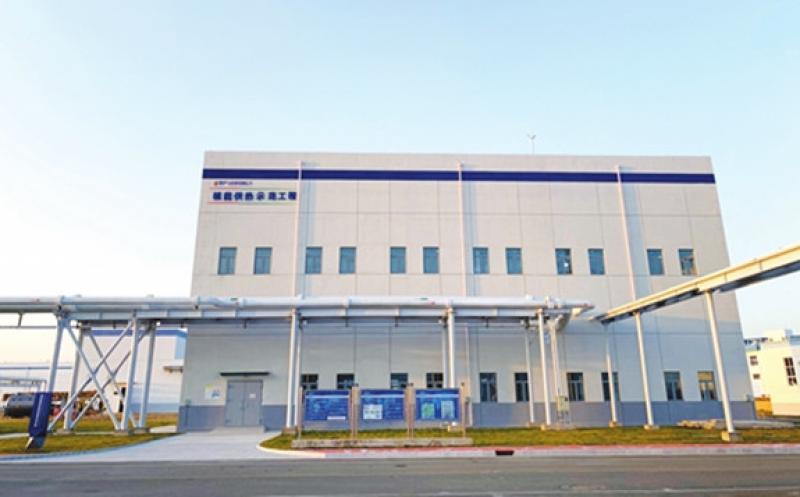While the East Chinese city of Haiyang's adaptation of nuclear power plant residual steam - China's first city to do so to heat homes - has triggered certain safety concerns, experts and industry insiders have dispelled such concern in recent days, stressing that the heating process does not involve exchanging hot water or radioactive substances, and thus is ultra safe and reliable.
 Nuclear power heating station in Haiyang, East China's Shandong Province Photo: Courtesy of SPIC
Nuclear power heating station in Haiyang, East China's Shandong Province Photo: Courtesy of SPIC
In a latest editorial to address China's nuclear energy development, the People's Daily said on Monday that China will develop nuclear energy in a managed and secure way, in order to optimize the country's energy structure, as well as ensuring the security of energy supply, thus achieving its double targets of carbon peak and carbon neutrality in addressing climate change.
The comment come after the second phase of the nuclear energy heating project in Haiyang city, East China's Shandong Province entered operation last week, an important breakthrough in China's nuclear energy heating strategy.
It is the first "zero carbon" residential heating city in China, meaning that the city has said goodbye to coal-fired heating, showing that China has ramped up efforts to promote clean energy when it comes to residential heating.
The nuclear energy heating project in Haiyang has become the world's largest cogeneration unit after the operation of the second phase of the heating project of 4.5 million square meters, which has replaced 12 local coal-fired water boilers and benefited 200,000 residents in Haiyang.
Safety concerns
The State Power Investment Corporation (SPIC), a major backer behind the Haiyang project, told the Global Times on Monday that since entering operation, the Haiyang Nuclear Power Unit 1, will save around 100,000 tons of raw coal each heating season, as well as reducing 180,000 tons of carbon dioxide emissions, equivalent to planting 1,000 hectares of broadleaf forest, which will effectively improve the air and marine ecological environment during the heating seasons.
Following the Haiyang project coming online, the heating cost for local residents has been reduced by one yuan ($0.16) per square meter of building compared with previous levels, which has warmed people's hearts and benefited their livelihood.
The SPIC told the Global Times that the nuclear power plants extract high-pressure residual steam from each nuclear power unit as the heat source, and then carry out a multi-stage heat exchange through the station, finally transfer the heat to residential areas through the municipal heating pipeline network.
During this process, only heat is transferred without any exchanged hot water or radioactive substances entering the heating pipes of customers, which ensures the safety and reliability of nuclear energy heating, according to SPIC.
"China has the ability to ensure the safe use of nuclear energy heating with its complete operation system and mature technology, so it is not necessary to be overly concerned about safety," Han Xiaoping, chief analyst at energy industry website china5e.com, told the Global Times on Monday.
Over the past 30 years, China's nuclear energy sector has developed rapidly. As of the end of August 2021, the country has 51 nuclear power units in operation, with an installed capacity of 53.26 million kilowatts, industrial data shows.
Green transition
At present, Haiyang's nuclear energy heating project is heating 30 million square meters of residential floorspace in the city. A senior official from the Energy Administration in Shandong said that the province will focus on building a 10-megawatt nuclear power base on the Jiaodong peninsula and actively promote the use of nuclear energy for heating and other purposes.
"The average temperature of my house can reach more than 23 degrees Celsius," a resident surnamed Cheng in Haiyang said, expressing his happiness about the new energy heating due to its lower cost and higher temperature.
The Haiyang project has improved thermal usage efficiency and economy of nuclear power, Liu Hua, an official from the International Atomic Energy Agency, was quoted as saying in a statement sent to the Global Times, expressing hope for strengthening technical cooperation with China in comprehensive utilization of nuclear energy, as well as sharing China's successful experience with the international community.
Han said that "with the rapid development of China's nuclear energy, most areas in northern China may say goodbye to coal-fired heating and embrace the new energy heating for its cheaper cost and higher efficiency."
"Nuclear energy heating will become a new option to build a clean, efficient and diversified heating system in northern areas," Yu Bing, deputy director of the National Energy Administration was quoted as saying in a statement sent to the Global Times. He noted that nuclear energy heating has brought nuclear power into mainstream public consciousness, and that the government should further strengthen the guidance of public opinion and communicate well with the public to reduce their concerns.
From January to August, China's nuclear power generation stood at 269.9 billion kilowatt hours, accounting for 5.01 percent of national power generation, a further increase compared with the end of 2020, but still far below the world average of 10 percent.